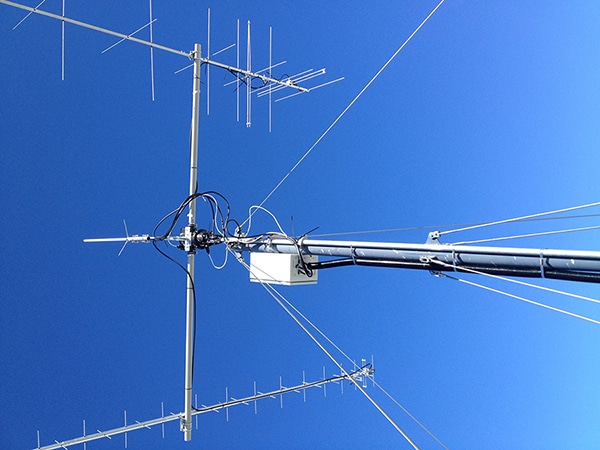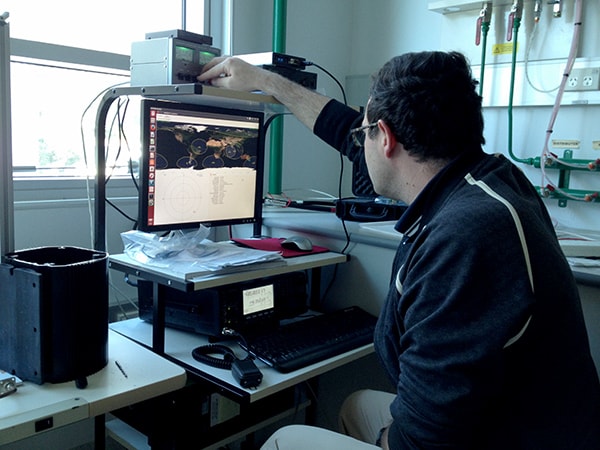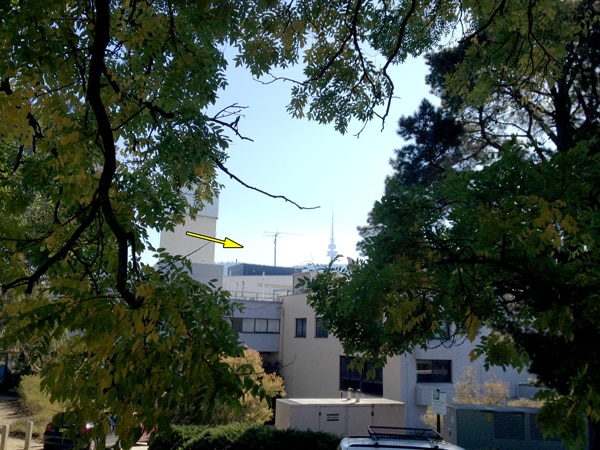INSPIRE-2: Cubesat

The project
The ‘INSPIRE-2’ satellite is a product of a research and capability-building partnership between three Australian universities (University of Sydney, UNSW, ANU), and is a participant in a global small satellite research program (‘QB50’) managed by the Von Karman Institute in Belgium.
The QB50 Mission involves a constellation of 28 CubeSats (including INSPIRE-2) at an altitude of 415 km as well as 8 CubeSats at an altitude of 500 km in sun synchronous orbit.
The CubeSats are now conducting multi-point, in-situ, long duration measurements of different gaseous molecules and electrical properties of the poorly studied and previously inaccessible thermosphere. Over a period of 1 to 2 years, the project will monitor the thermosphere to better understand space weather and its long-term trends. The QB50 CubeSats carry either a multi-Needle Langmuir Probe (m-NLP), Ion-Neutral Mass Spectrometer (INMS) or Flux-Φ-Probe Experiment (FIPEX), as well as their own additional payloads.
INSPIRE-2 was launched into Space as part of a NASA-contracted resupply mission to the International Space Station (ISS) on an Atlas V Rocket from the commercial space services provider OrbitalATK, under contract with the NanoRacks LLC service provider. Nanoracks released INSPIRE-2 into orbit on 26th May 2017:
The QB50 launch was the first launch of Australian built and operated CubeSat spacecraft. Given international recognition that this form of spacecraft will increasingly be used for future Earth observation, navigation and communication roles, this activity offers a significant national capability-building benefit in the sector, as well as the opportunity to demonstrate utility and space qualification of proprietary instrumentation for several research applications. It is also closely aligned with a University of Sydney-led multi-party bid to establish an ARC Industrial Transformation Research Program Training Centre, which was succesfully funded in June 2017.
Project information
| Mission attribute | Details |
|---|---|
| Reference number | AU03 ‘INSPIRE-2’ |
| Size | 20cm x 10cm x 10cm; 2 Unit CubeSat format |
| Mass | 2000 gm (2 kg) |
| Equipment | Commercial ‘off-the-shelf’ control and operating systems; 5 research instruments |
| Mission purpose | Scientific research and national capacity building |
| Altitude at launch | 415km |
| Mission duration | 1-2 years |
| Mission conclusion | Complete burn-up in upper atmosphere at >80km altitude |
The INSPIRE-2 craft is a two-unit (2U) cubesat. The craft uses commercial ‘off-the-shelf’ componentry for basic structural purposes and control functions, and carries a payload of five research instruments. One of the instruments (the Langmuir Probe) is supplied by the VKI for integrated program research purposes; the other four instruments are proprietary devices developed by the University of Sydney (USyd) and UNSW. The craft does not carry any substances/ materials of a flammable, corrosive or otherwise hazardous nature.
The craft was assembled in the Faculty of Science (USyd) and Faculty of Electrical Engineering (UNSW), and validated for space capability at the Mount Stromlo facilities of the Australian National University (ANU). INSPIRE-2 was then consigned to the VKI, from where it was packed by NanoRacks into the CubeSat Deployer apparatus, NanoRacks’ proprietary system “that mechanically and electrically isolates cubesats from the ISS, cargo resupply vehicles, and ISS crew” (NanoRacks CubeSat Deployer (NRCSD) Interface Control Document. NanoRacks LLC).
After launch into circular low Earth orbit the payload instruments commence operation and data capture and storage, with data downloads being made to groundstations in Sydney, ANU ('Blue Wren' Groudstation) and Strasbourg, France. Communication access through these locations will occur an estimated 4 and 6 times per day, respectively, with total daily access durations of 21.6 and 28.6 minutes.
At an estimated 1 - 2 years post-launch, orbital decay due to friction with air molecules will pull INPSIRE-2 into the upper reaches of Earth's atmosphere. This friction will slow, melt, fragment and degrade the craft to a non-operational state. Detailed modelling (Fritsche, B. 2015. Uncertainty quantification for re-rentry survivability prediction. From ‘Space Safety is No Accident’. Sgobba, T & Rongier, I., Eds. Springer, 640pp.) shows that the craft will completely burn up in the atmosphere at an altitude above 80km, and that no debris will reach the surface of the Earth. This assessment is consistent with empirical observations of the outcomes of international CubeSat missions to date.
The 'Blue Wren' ground station at the Australian National University has been set up for INSPIRE-2. There are also ground stations at The University of New South Wales and in Strasbourg, France which will communicate with the satellite in orbit.



The University of Sydney
- Overall leadership
- Three of the five payloads (Nanospec, radiation counter, microdosimeter)
- Collaboration on scientific and engineering data
The University of New South Wales
- Designing, building and integrating the spacecraft
- 'Kea' GPS Receiver payload
- Collaboration on engineering data
The Australian National University
- Provision of funds
- Advanced Instrumentation and Technology Centre (AITC) Testing
- Collaboration on science and engineering data - especially on mNLP instruments
The team

Members of the INSPIRE-2 collaboration and colleagues at the Delta-V stand at CEBIT in 2014. From back left: Iver Cairns, Xiaofeng Wu, Tim Parsons (Delta-V), Jason Held (Saber Astronautics), Barnaby Osborne. From front left: Andrew Dempster, Brian Lim (Hypercubes) and Cheryl Brown (ACSER).
Name |
Responsibility |
Location |
Iver is the Lead for the AU03 INSPIRE-2 QB50 team |
School of Physics, The University of Sydney |
|
Christine is collaborating on mNLP integration and design of AU03 INSPIRE-2 |
Space Plasma, Power and Propulsion laboratory, Australian National University |
|
Andrew is the Leader of AU02 UNSW ECO CubeSat for QB50 and is collaborating with the design and build of AU03 INSPIRE-2 |
School of Electrical Engineering and Telecommunications, University of New South Wales |
Barnaby is working on the design and build of AU03 INSPIRE-2 |
School of Electrical Engineering and Telecommunications, University of New South Wales |
|
Joon is working on the design and build of AU03 INSPIRE-2 |
School of Electrical Engineering and Telecommunications, University of New South Wales |
|
Wayne Peacock |
Wayne worked on the design and build of AU03 INSPIRE-2 |
|
Tom Croston |
Tom is working on the design and build of AU03 INSPIRE-2 |
|
John Lam |
John is developing software for AU03 INSPIRE-2 |
School of Electrical Engineering and Telecommunications, University of New South Wales |
Ben Southwell |
Ben is working on the attitude determination and control system of AU03 INSPIRE-2 |
School of Electrical Engineering and Telecommunications, University of New South Wales |
|
Space Plasma, Power and Propulsion laboratory, Australian National University |
|
Jiro Funamoto |
Jiro is designing several of the payload boards, developing the software and working on the mNLP integration for AU03 INSPIRE-2 |
School of Physics, The University of Sydney |
Joe is developing the radiation counter for AU03 INSPIRE-2 |
School of Physics, The University of Sydney |
|
Sergio and Chris Betters are developing the Nanospec for AU03 INSPIRE-2 |
School of Physics, The University of Sydney |
|
Chris and Sergio Leon-Saval are developing the Nanospec for AU03 INSPIRE-2 |
School of Physics, The University of Sydney |
|
Xiaofeng is developing the microdosimeter for AU03 INSPIRE-2 |
School of Aerospace, Mechanical, and Mechatronic Engineering (AMME), The University of Sydney |
Dr Tony Monger |
Tony is working on AU03 INSPIRE-2's communications system |
|
Dimitrios is working on AU03 INSPIRE-2's communications system |
|
Dr David Dall |
David has provided legal counsel and research management advice for AU03 INSPIRE-2 |
Department of Agriculture and Water Resources |
Helen is providing legal counsel for AU03 INSPIRE-2 |
Office of General Counsel, University of Sydney |
Stefan Manidis |
Stefan is providing project coordination and communications support for AU03 INSPIRE-2 |
School of Physics, The University of Sydney |
Media
- Australian Space Engineers Rescued Two Satellites
Gizmodo, June 27 2017 - Australia's INSPIRE-2 mini cube satellite launched with flat battery
The Canberra Times, June 22 2017 - E.T. Phone Home: Australian scientists find satellite lost in space
ABC Radio PM, June 22 2017 - Inspired detective work finds Australian satellite in space
University of Sydney News, June 22 2017 - Australia's 'loaf of bread' satellite is now orbiting Earth
Business Insider Australia, May 29 2017 - Australia makes it back to space with cubesats
The Prototype (Warren Centre), April 21, 2017 - Australia returns to space with three mini satellites successfully launched to the Space Station
Sydney Morning Herald, April 20, 2017 - Satellites signal new low-cost space race
SBS News, April 19, 2017 - Fleet of CubeSats launches to study the neglected ‘ignorosphere’
New Scientist Online, April 18, 2017 - Australia’s back in the satellite business with a new launch
The Conversation, April 18, 2017 - CubeSat's blast off on climate mission
ABC Radio, The World Today, April 19, 2017 - Three Australian research satellites launched into space from Cape Canaveral
The Daily Telegraph, April 19, 2017 - These Tiny, Cube-Shaped Satellites Are Launching Australia Back Into Space
The Huffington Post AU, April 19, 2017 - Satellites set for launch
Sky News, April 19, 2017 - Satellite built by University of Adelaide launched into space by NASA
ABC News Online, April 20, 2017 - South Australian satellite blasts into space
9news.com.au, April 19, 2017 - Australia launching into space again
Sydney University News, August 10, 2016 - Australian know-how used to design 'planetary probes' to explore Earth's thermosphere
Sydney Morning Herald, August 9, 2016 - Australian '$1m lunch box' satellites to search thermosphere for answers
Guardian Online, August 9, 2016 - The CubeSats mark the first time in 15 years that Australia has built satellites
ABC News Online, August 9, 2016 - Australian 'mini-satellites' to study Earth's thermosphere in global research project
ABC News Online, August 9, 2016 - Australian mini-satellites to explore Earth's thermosphere; 3 Australian universities to make history
International Business Times, August 9, 2016 - Swarm of satellites to explore Earth's shield from International Space Station
EurekAlert!, August 9, 2016 - Australian mini-satellites undergo space testing before launch later this year
ABC News Online, June 14, 2016
